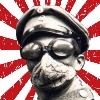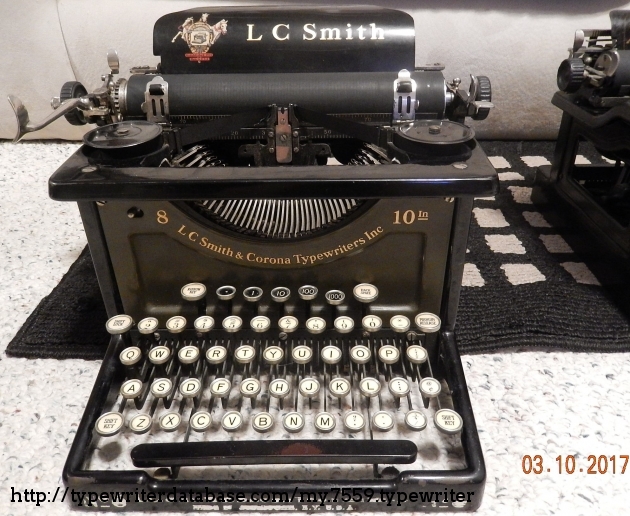
- schyllerwade
- Speed Champion
 Offline
Offline - Registered: 11-6-2017
- Posts: 251
Re: Recent Acquisitions Thread
Well that was certainly an entertaining bit, but I'm glad you shared it with us. I went out just now and went to an art supply store where they had a different brand of 100% mineral spirits called Gamsol. $18 per liter, so not cheap! . I went through the segment once more, working each key individually and also hitting all the pivot points of that particular type bar,. I've managed to get all the keys moving freely with the exception of one, the "U" key. I suppose I'll hit it with a few more applications/angles, but otherwise if I can get that moving, this typewriter should be ready to go. Sadly I think I may have messed up some of the paint in various spots by being careless with some of the chemicals I was using, but that's another story.
- Uwe
- Moderator
 Offline
Offline 
- From: Toronto, Canada
- Registered: 12-3-2013
- Posts: 4,410
Re: Recent Acquisitions Thread
Fleetwing wrote:
3 en 1 = WD40?
The 3-IN-ONE brand sells its own penetrating oil products that is an equivalent to WD-40, and seems to be available internationally. It is not the same as the general purpose 3-IN-ONE oil.
Obviously everyone is free to do what they want, how they want, with their typewriters, but every time someone mentions WD-40 in this forum I will continue, for the sake of newbies who don't know better, to warn against its use. It can have its uses when working on a typewriter under special circumstances (although I'd argue that there are far superior products available than WD-40), but it's not some miracle, fix-all spray that WD-40 likes to market it as. I have bought machines that had been completely sprayed top to bottom in that horrid stuff, and cursed a blue streak every time because it meant that I had to dunk clean the machine to get rid of the stuff.
I work on a LOT of typewriters, and the two products that I predominantly use are mineral spirits to completely clean mechanical parts, and only AFTER they've been thoroughly cleaned, sewing machine oil to lubricate only those parts that should be lubricated.
The pronoun I has always been capitalized in the English language for more than 700 years.
- •
- schyllerwade
- Speed Champion
 Offline
Offline - Registered: 11-6-2017
- Posts: 251
Re: Recent Acquisitions Thread
Noted. I have yet to oil any typewriter because I don't know the proper terminology and I've only come across threads that name which parts to oil (no images). I wish there was a diagram that had pictures with individual parts numbered/named/labeled so I could see what parts are supposed to be oiled and which are not.
one can hope.
- Javi
- Touch Typist
 Offline
Offline 
- From: Valladolid (Spain)
- Registered: 27-5-2016
- Posts: 182
Re: Recent Acquisitions Thread
Uwe wrote:
, sewing machine oil to lubricate only those parts that should be lubricated.
El aceite de los 1000 usos (the thousand uses oil), as it is marketed here. Or at least that's the brand I use, and it works wonders. That, and the weird mixture sold at the hardware store of my village which is unbeatable against nicotine stains are the true stars of my tools.
TaktaktataktaktakcluccluctaktaktaktaktakDINGtaktaktaktakCREEEEEEEEECtaktaktak...
(Olivetti Linea 98)
- schyllerwade
- Speed Champion
 Offline
Offline - Registered: 11-6-2017
- Posts: 251
Re: Recent Acquisitions Thread
This little guy is a 1966
cursive too (yes I know "script" is the correct term)
Needed a little help, paper support was bent, Bell was not working, and a few keys were sticky
Apparently he's had touch control… Never knew that 

- schyllerwade
- Speed Champion
 Offline
Offline - Registered: 11-6-2017
- Posts: 251
Re: Recent Acquisitions Thread
*these had touch control
- schyllerwade
- Speed Champion
 Offline
Offline - Registered: 11-6-2017
- Posts: 251
Re: Recent Acquisitions Thread
Remington Noiseless Deluxe
Far from perfect, very hard platen, #2 key doesn't work, vibrator sticks on red, no case
Otherwise it seems to be in very good mechanical condition
And a good deal quieter then my other machines, even with the hardened platen. I have to imagine this machine would have an extremely quiet overall operation with a newly recovered platen...
- Fleetwing
- Typewriter Talk Vet
 Offline
Offline - From: Hartford, CT USA
- Registered: 30-6-2015
- Posts: 1,015
Re: Recent Acquisitions Thread
Just got over the weekend a Noiseless Portable 7, from 1948. It's in really nice condition, and I am stunned at how quiet it is. It really is not much louder, and sounds similar to, typing with a laptop. At first I was convinced that it wasn't typing properly, but then I looked at the paper and the printing was very clear and crisp. The platen is soft -- may have been re-covered along the way. But overall the machine is in tip-top condition. Most impressive. Paid $30 for it.
- OliverNo.9
- Touch Typist
 Offline
Offline 
- From: CT
- Registered: 02-4-2016
- Posts: 140
Re: Recent Acquisitions Thread
Fleetwing wrote:
Just got over the weekend a Noiseless Portable 7, from 1948. It's in really nice condition, and I am stunned at how quiet it is. It really is not much louder, and sounds similar to, typing with a laptop. At first I was convinced that it wasn't typing properly, but then I looked at the paper and the printing was very clear and crisp. The platen is soft -- may have been re-covered along the way. But overall the machine is in tip-top condition. Most impressive. Paid $30 for it.
I wonder if that is the secret to getting a noiseless machine to print well; a recovered platen. Most of the noiseless machines I have had have had hard platens and the print quality was just ok. That does make sense, the platen would shrink over time causing the distance the type slug has to travel to the print point to increase.
That's my theory anyways.
- Markmotown
- Touch Typist
 Offline
Offline - From: Villanova, PA
- Registered: 16-12-2015
- Posts: 183
Re: Recent Acquisitions Thread
Bought a 1903 Remington Standard No. 7 on Craigslist for $40. It'll be a long term project, since it is a mess.
I was going to post pics of it--and the unusual "f.o.b." key, but apparently Photobucket has turned-off 3rd-party hosting for its free accounts, so they've locked-down all of the photos I've already shared to this site, unless I pay a monthly subscription fee. And that seems a bit blackmail-y.


